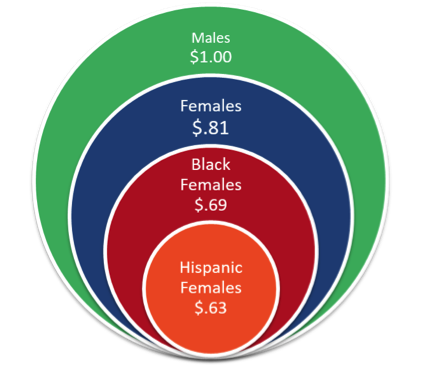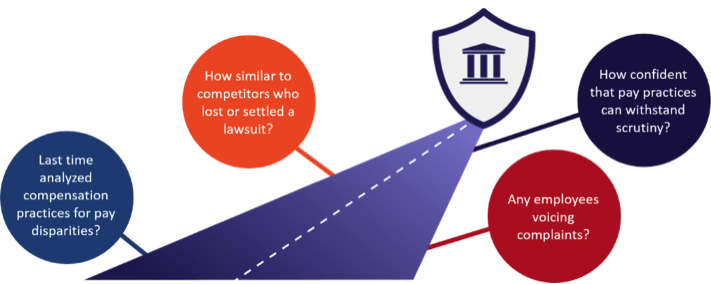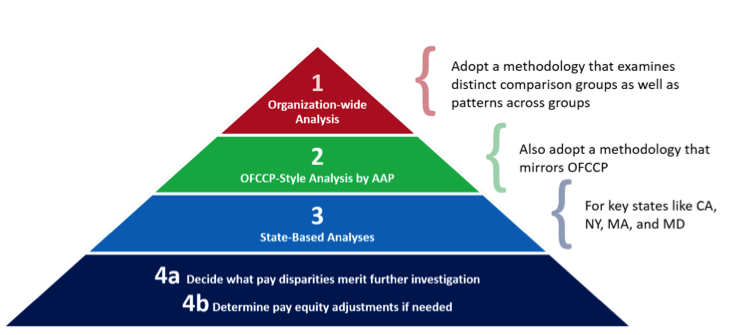If superheroes are willing to fight for truth, justice, and the American Way, then surely they would fight for pay equity, wouldn’t they?
If compensated for all their good deeds, Wonder Woman would fare as well as Superman, right? Wouldn’t the Avengers quickly dispel a gender wage gap where females earn 81 cents for each dollar earned by males, and Black and Hispanic females lag even further behind at 69 cents and 63 cents, respectively?

The Gender Wage Gap
I imagine most companies would want an HR superhero who wields a sword in one hand to protect employees against pay discrimination and a shield in the other to defend the company if claims of discrimination arise. What unique powers would such a superhero possess?
Holy Curiosity, Batman!
First, our HR superhero would be endowed with great curiosity, ready to seek answers to key questions:
- When was the last time our company analyzed its compensation practices for gender- or race-based pay disparities?
- Are any groups of employees by gender or race voicing complaints about how starting pay rates, merit increases, or bonuses are determined?
- How similar is our company’s compensation philosophy and pay structure to competitors who have recently lost or settled a pay discrimination lawsuit?
- Would our company’s compensation practices withstand scrutiny by anti-discrimination enforcement agencies?

Questions to Assess Company’s Risk of Pay Discrimination Claims
It a Bird, it’s a Plane, it’s…Depth of Legal Knowledge
Secondly, our HR superhero would have a thirst for knowledge, eager to understand the legal foundations for a pay discrimination finding.
Such a superhero could readily recite the different protected statuses recognized in anti-discrimination laws, including sex, race, color, religion, national origin, age, and disability.
Our superhero would know the different legal theories of discrimination, including
- Disparate treatment – Intentionally treating employees of some protected status differently.
- Disparate impact – A policy or practice that appears neutral on its face but has the effect of disproportionately placing many people of some protected status at a disadvantage.
- Repeated violation theory of pay discrimination – Each paycheck that delivers compensation tainted by a past discriminatory decision repeats the original discriminatory decision, even if that initial decision was made many years ago.
They would also investigate pay disparities by comparing employees under appropriate legal standards, such as the “similarly situated” standard from Title VII of the Civil Rights Act or the “substantially equal” standard from the Equal Pay Act.
The Power of Data
Next, our HR superhero would draw strength from data, seeking to collect the information needed for a meaningful pay equity analysis, including
- Job-related fields that are useful in forming employee comparison groups (e.g., job title, job family, and job function).
- Important dates for computing years of service and tenure (e.g., service date and job entry date).
- Compensation structure fields that help explain differences in pay (e.g., pay grade and salary administration plan).
- Organizational fields for which patterns of pay disparity may be assessed (e.g., business unit and department).
Other data to consider include explanatory factors such as performance ratings, educational attainment, and prior work experience.
Risk Assessment to the Rescue!
Lastly, our HR superhero would take a comprehensive approach to risk assessment. Pay equity analyses would identify any patterns of pay disparity across the organization that may support class action claims by the EEOC or plaintiffs’ bar. Additional studies would help a federal contractor anticipate what the OFCCP may find in an audit by adopting an OFCCP-style methodology that compares employees at the level of the affirmative action program.
Recognizing that a growing list of states are revising their equal pay laws, the HR superhero would also conduct state-based analyses, particularly for employees in California, New York, Maryland, and Massachusetts. From these various studies, our superhero would determine what disparities warrant further investigation and whether any pay equity adjustments are needed.

Take a Comprehensive Approach
By combining a solid understanding of the legal foundations for pay discrimination claims with meaningful data and a comprehensive investigation, our HR superhero can forge a shield of protection from enforcement actions by the EEOC and OFCCP and from costly pay discrimination lawsuits.
Are your ready to be an HR superhero? Draw your sword, lift your shield, and lead the fight for truth, justice, and pay equity for all!
 About the Author
About the Author
Charles McGhee, PhD serves as Affirmity’s lead statistician. He has over 20 years of expertise in workforce compliance, in the private and public sectors. Prior to joining Affirmity, he served for 10 years as senior statistician with the Office of Federal Contract Compliance Programs (OFCCP) and Equal Employment Opportunity Commission (EEOC). Dr. McGhee holds a PhD in Biostatistics, and undergraduate and Master’s degrees in Mathematics.
